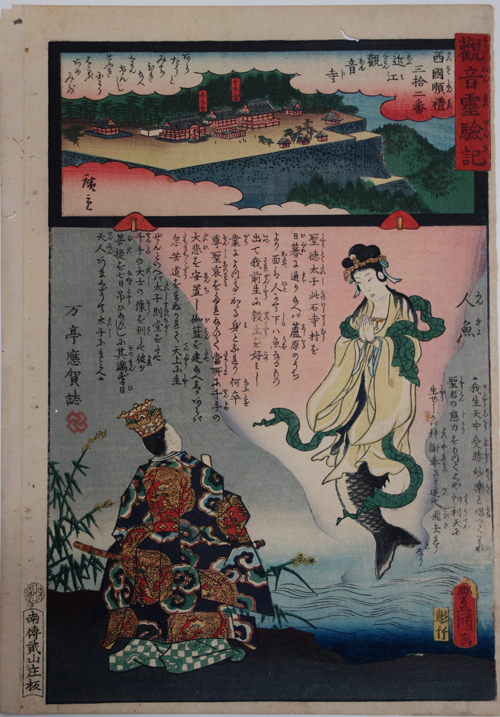Sacred Space and Japanese Art at the Spencer Museum of Art
Entry by Sherry Fowler
Kannonji, also known as Kannonshōji, located in present-day Shiga Prefecture east of Lake Biwa, is the thirty-second stop on the Saikoku Kannon pilgrimage route. As in all the prints in the Kanzeon reigenki set, this one has a framed landscape of the temple’s buildings illustrated by Hiroshige II above and a dramatic image of a temple legend illustrated by Kunisada below.
The text in the lower scene explains that as Prince Shōtoku (c. 574–622) was passing by a field of rushes in Ishidera Village at sunset, a strange half-human and half-fish being appeared. The creature explained that she had been transformed into a mermaid because of the bad karma she accrued from enjoying killing living beings as a fisherman. She said that if the Prince could take pity on her and build a temple to enshrine an image of the Thousand-armed Kannon, her suffering would soon end and she could be born in paradise. Right away the Prince built the temple, carved an image of the Thousand-armed Kannon, and then held a seven-day ritual for the mermaid. On the seventh day she descended and said, “Because of the power of the Prince’s compassion, I have already been reborn in heaven.” Thereupon she thanked the Prince and flew away.
This miraculous story with its connection to Prince Shōtoku, who has been heralded as one of the earliest major proponents of Buddhism in Japan, affirms the temple as a sacred space and assures that it is worthy to be one of the Saikoku thirty-three pilgrimage temples dedicated to Kannon.

Kannonji (Number 32) from the series Saikoku sanjūsansho, Kannon reigenki ( Thirty-three temple pilgrimage of the western country, chronicle of Kannon miracles)
Japan, Utagawa Kunisada (1786–1864) and Utagawa Hiroshige II (1826–1869)
1859, Edo period (1615–1868)
Color woodcut
36.4 x 25.5 cm
Private collection
